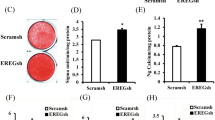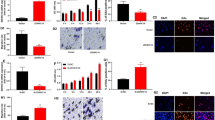Abstract
Objectives
Triethylene glycol dimethacrylate (TEGDMA) is a common component of resin-based dental composites and endodontic sealers. TEGDMA induces apoptosis in several types of cells. However, the mechanisms are not completely understood. The aim of this study was to investigate the mechanisms underlying TEGDMA-induced apoptosis in human embryonic palatal mesenchymal (HEPM) pre-osteoblasts and primary human dental pulp (HDP) cells.
Material and methods
Cell viability was examined after TEGDMA treatment. Cell cycle progression was checked by flow cytometry. Apoptotic cells were evaluated using terminal deoxynucleotidyl transferase (TdT)-mediated dUTP nick end labeling assay and visualized by fluorescence microscopy. Western blot analyses were performed to determine expressions of apoptosis-related proteins. The production of reactive oxygen species (ROS) was detected using flow cytometry. NADPH oxidase 4 (NOX4) expression levels were investigated using real-time quantitative polymerase chain reaction and Western blot analyses.
Results
TEGDMA increased cytosol cytochrome c levels and activated caspase-9 in HEPM and HDP cells. TEGDMA decreased the expression of anti-apoptotic protein Bcl-XL. TEGDMA-induced apoptosis was inhibited by caspase-9-specific inhibitor, anti-oxidants, NOX inhibitor, NOX4 inhibitor, and NOX4 small interfering RNA (siRNA). TEGDMA increased ROS production and upregulated NOX4 mRNA and protein expression. TEGDMA-induced intracellular ROS production was inhibited by NOX inhibitor and NOX4 inhibitor.
Conclusions
We demonstrate significant involvement of NOX4 in the TEGDMA-induced ROS. NOX4-derived ROS subsequently induces mitochondrial cytochrome c release leading to apoptosis through activation of the intrinsic apoptotic pathway.
Clinical relevance
NOX4 may be a potential target for strategies to prevent or ameliorate the TEGDMA-induced toxicity in HEPM and HDP cells.




Similar content being viewed by others
References
Peutzfeldt A (1997) Resin composites in dentistry: the monomer systems. Eur J Oral Sci 105:97–116
Navarro M, Michiardi A, Castano O, Planell JA (2008) Biomaterials in orthopaedics. J R Soc Interface 5:1137–1158
Van Landuyt KL, Nawrot T, Geebelen B, De Munck J, Snauwaert J, Yoshihara K et al (2011) How much do resin-based dental materials release? A meta-analytical approach. Dent Mater 27:723–747
Geurtsen W, Leyhausen G (2001) Chemical-biological interactions of the resin monomer triethyleneglycol-dimethacrylate (TEGDMA). J Dent Res 80:2046–2050
Krifka S, Spagnuolo G, Schmalz G, Schweikl H (2013) A review of adaptive mechanisms in cell responses towards oxidative stress caused by dental resin monomers. Biomaterials 34:4555–4563
Schweikl H, Spagnuolo G, Schmalz G (2006) Genetic and cellular toxicology of dental resin monomers. J Dent Res 85:870–877
Galluzzi L, Maiuri MC, Vitale I, Zischka H, Castedo M, Zitvogel L et al (2007) Cell death modalities: classification and pathophysiological implications. Cell Death Differ 14:1237–1243
Reichl FX, Esters M, Simon S, Seiss M, Kehe K, Kleinsasser N et al (2006) Cell death effects of resin-based dental material compounds and mercurials in human gingival fibroblasts. Arch Toxicol 80:370–377
Krifka S, Petzel C, Bolay C, Hiller KA, Spagnuolo G, Schmalz G et al (2011) Activation of stress-regulated transcription factors by triethylene glycol dimethacrylate monomer. Biomaterials 32:1787–1795
Spagnuolo G, Galler K, Schmalz G, Cosentino C, Rengo S, Schweikl H (2004) Inhibition of phosphatidylinositol 3-kinase amplifies TEGDMA-induced apoptosis in primary human pulp cells. J Dent Res 83:703–707
Samuelsen JT, Dahl JE, Karlsson S, Morisbak E, Becher R (2007) Apoptosis induced by the monomers HEMA and TEGDMA involves formation of ROS and differential activation of the MAP-kinases p38, JNK and ERK. Dent Mater 23:34–39
Harorli OT, Bayindir YZ, Altunkaynak Z, Tatar A (2009) Cytotoxic effects of TEGDMA on THP-1 cells in vitro. Med Oral Patol Oral Cir Bucal 14:e489–e493
Fischer U, Schulze-Osthoff K (2005) New approaches and therapeutics targeting apoptosis in disease. Pharmacol Rev 57:187–215
Giansanti V, Torriglia A, Scovassi AI (2011) Conversation between apoptosis and autophagy: “is it your turn or mine?”. Apoptosis 16:321–333
Batarseh G, Windsor L, Labban N, Liu Y, Gregson K (2014) Triethylene glycol dimethacrylate induction of apoptotic proteins in pulp fibroblasts. Oper Dent 39:E1–E8
Yang WH, Deng YT, Kuo MY, Liu CM, Chang HH, Chang JZ (2013) Epigallocatechin-3-gallate blocks triethylene glycol dimethacrylate-induced cyclooxygenase-2 expression by suppressing extracellular signal-regulated kinase in human dental pulp and embryonic palatal mesenchymal cells. J Endod 39:1407–1412
Yeh CC, Deng YT, Sha DY, Hsiao M, Kuo MY (2009) Suberoylanilide hydroxamic acid sensitizes human oral cancer cells to TRAIL-induced apoptosis through increase DR5 expression. Mol Cancer Ther 8:2718–2725
Kok S, Yeh C, Chen M, Kuo MY (2009) Esculetin enhances TRAIL-induced apoptosis through DR5 upregulation in human oral cancer SAS cells. Oral Oncol 45:1067–1072
Bakopoulou A, Papadopoulos T, Garefis P (2009) Molecular toxicology of substances released from resin-based dental restorative materials. Int J Mol Sci 10:3861–3899
Marchi S, Giorgi C, Suski JM, Agnoletto C, Bononi A, Bonora M et al (2012) Mitochondria-Ros crosstalk in the control of cell death and aging. J Signal Transduct 2012:329635
Serrander L, Cartier L, Bedard K, Banfi B, Lardy B, Plastre O et al (2007) NOX4 activity is determined by mRNA levels and reveals a unique pattern of ROS generation. Biochem J 406:105–114
Noda M, Wataha JC, Kaga M, Lockwood PE, Volkmann KR, Sano H (2002) Components of dentinal adhesives modulate heat shock protein 72 expression in heat-stressed THP-1 human monocytes at sublethal concentrations. J Dent Res 81:265–269
Paranjpe A, Cacalano NA, Hume WR, Jewett A (2007) N-acetylcysteine protects dental pulp stromal cells from HEMA-induced apoptosis by inducing differentiation of the cells. Free Radic Biol Med 43:1394–1408
Altenhofer S, Kleikers PW, Radermacher KA, Scheurer P, Rob Hermans JJ, Schiffers P et al (2012) The NOX toolbox: validating the role of NADPH oxidases in physiology and disease. Cell Mol Life Sci 69:2327–2343
Schweikl H, Petzel C, Bolay C, Hiller K, Buchalla W, Krifka S (2014) 2-Hydroxyethyl methacrylate-induced apoptosis through the ATM- and p53-dependent intrinsic mitochondrial pathway. Biomaterials 35:2890–2904
Acknowledgments
This work was supported by research grants from the National Taiwan University Hospital and the National Science Council, Taiwan.
Conflict of interest
The authors declare that they have no conflict of interest.
Author information
Authors and Affiliations
Corresponding author
Additional information
Cheng-Chang Yeh and Jenny Zwei-Chieng Chang contributed equally to this work.
Rights and permissions
About this article
Cite this article
Yeh, CC., Chang, J.ZC., Yang, WH. et al. NADPH oxidase 4 is involved in the triethylene glycol dimethacrylate-induced reactive oxygen species and apoptosis in human embryonic palatal mesenchymal and dental pulp cells. Clin Oral Invest 19, 1463–1471 (2015). https://doi.org/10.1007/s00784-014-1370-7
Received:
Accepted:
Published:
Issue Date:
DOI: https://doi.org/10.1007/s00784-014-1370-7




